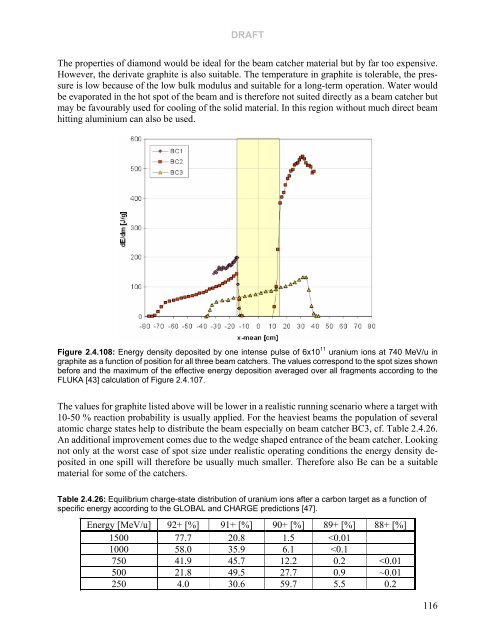Technical Design Report Super Fragment Separator
Technical Design Report Super Fragment Separator
Technical Design Report Super Fragment Separator
Create successful ePaper yourself
Turn your PDF publications into a flip-book with our unique Google optimized e-Paper software.
DRAFT<br />
The properties of diamond would be ideal for the beam catcher material but by far too expensive.<br />
However, the derivate graphite is also suitable. The temperature in graphite is tolerable, the pressure<br />
is low because of the low bulk modulus and suitable for a long-term operation. Water would<br />
be evaporated in the hot spot of the beam and is therefore not suited directly as a beam catcher but<br />
may be favourably used for cooling of the solid material. In this region without much direct beam<br />
hitting aluminium can also be used.<br />
Figure 2.4.108: Energy density deposited by one intense pulse of 6x10 11 uranium ions at 740 MeV/u in<br />
graphite as a function of position for all three beam catchers. The values correspond to the spot sizes shown<br />
before and the maximum of the effective energy deposition averaged over all fragments according to the<br />
FLUKA [43] calculation of Figure 2.4.107.<br />
The values for graphite listed above will be lower in a realistic running scenario where a target with<br />
10-50 % reaction probability is usually applied. For the heaviest beams the population of several<br />
atomic charge states help to distribute the beam especially on beam catcher BC3, cf. Table 2.4.26.<br />
An additional improvement comes due to the wedge shaped entrance of the beam catcher. Looking<br />
not only at the worst case of spot size under realistic operating conditions the energy density deposited<br />
in one spill will therefore be usually much smaller. Therefore also Be can be a suitable<br />
material for some of the catchers.<br />
Table 2.4.26: Equilibrium charge-state distribution of uranium ions after a carbon target as a function of<br />
specific energy according to the GLOBAL and CHARGE predictions [47].<br />
Energy [MeV/u] 92+ [%] 91+ [%] 90+ [%] 89+ [%] 88+ [%]<br />
1500 77.7 20.8 1.5















